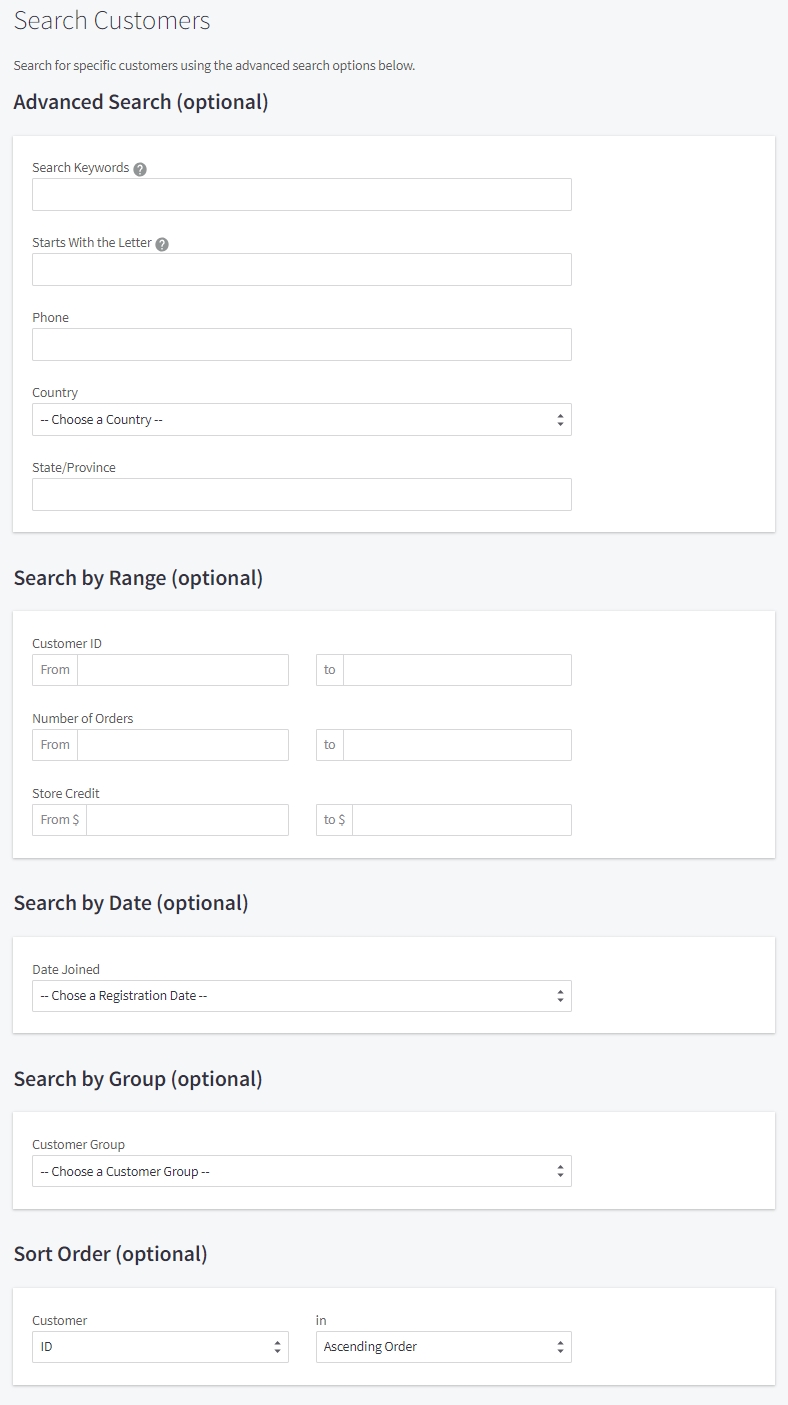Managing Customer Accounts
Chapter 2 (View all Chapters)
Managing Your Customers' Accounts
Your store’s control panel sports many helpful tools to help you organize and manage your customer accounts. You’re able to search your customers’ data, decide what extra information is required for account creation, issue store credit to customers, and segment your customers into different cohorts using the customer groups feature.
Searching Customers
Finding customer records is as simple as performing a standard, filtered search. In the search bar at the top of the control panel, type in part of a customer’s name or email address, and the View Customers screen will return a list of all matching results.

Customer search results can be sorted (ascending or descending) by whichever customer data point you choose (e.g. last name, date joined, number of orders).
If you need to get more specific or want to discover customer cohorts, there is an advanced search function in the View Customers section of the control panel that allows for you to get more granular with customer details, including:
- First name
- Last name
- Email address
- Company name
- Phone number
- Country
- State
- Number of orders
- Date joined
- Customer group

Store Credit
Store owners can grant store credit right from the control panel to customers who’ve created an account. Although offering store credit doesn’t suit every business, there are certainly advantages.
- Rewarding customers — Store credit can be given to reward customers for their business, referrals and overall support.
- Encourage sales — Store credit can be given to encourage sales during certain time periods to help you generate extra revenue.
- Promotional offering — Store credit can also be used in conjunction with sales promotions, such as giving a certain customer segment a $5 store credit to incentivize them to visit the store and shop around. This is similar to how brick and mortar stores will sometimes offer gift cards along with higher-ticket items. It’s useful for both shoppers and merchants. Shoppers see it as free money or a discount, and store owners benefit since the credit can only be redeemed at their store.
- Back pocket offer for a poor experience — Offering your customers store credit can prove to be a quick and easy tool as part of your larger customer service strategy. For customers who have a particularly negative experience, you can offer store credit as a way to say “sorry for the inconvenience.” Offering an olive branch in this way might prevent the customer from taking their complaints public in a bad review or a rant on social media.
Customer Groups
Advanced customer segmentation, also known as Customer Groups, gives you, the store owner, the ability to classify customers into different segments, or groups. You can create groups based on a variety of criteria including:
- preferred customer group, who receive discounts on certain products, categories or the whole store
- tax-exempt group for nonprofit or governmental customers
- wholesale group who get discounted prices on bulk purchases, and get access to products or categories typically hidden from retail customers
- gating your store’s “members only” content or products by requiring shoppers to register an account before being able to shop
Importing and Exporting Customers
Customer account details can be updated via a CSV file import. This is the fastest way to update existing customer information in bulk. The import process can also be used to add new customers en masse — this is handy when acquiring new client lists from events, brick and mortar efforts, or when migrating from another platform.
BigCommerce supports importing third-party customer CSV files by having a “match columns” feature during the import process, so you can map the third-party’s column names to their appropriate names in BigCommerce.
Pro Tip! Typically, you’ll want to use the Bulk Edit template when exporting customers, as it includes almost all exportable fields, and has columns already named using BigCommerce’s standards, allowing you to skip the “match columns” portion of the import process.
However, if you update your customer records on a regular basis, you may find it easier to work with a pared down CSV file. We allow you to create your own custom export templates to better fit your workflow.
Some of the customer data exported with the Bulk Edit template includes:
- email address
- name
- phone
- store credit
- customer group
- shipping address
Adding a Personal Touch with Custom Account and Address Fields
As a client creates their account, they will be walked through a standard set of form fields.

This form may include additional, custom fields that you can leverage to personalize the experience for your customers. Some of the most common custom fields that merchants add to their forms include:
- How did you hear about us? — this can be invaluable information for providing insight to your marketing campaigns. You can get a better idea of where your customers are coming from, and how a particular paid campaign is performing.
- Salesperson — helpful for tracking commission for stores with that business model
- Purchase Order Number — businesses that use a purchase order or quoting model often use this to cross reference orders
- Birthday — can be used as a fun marketing technique to offer sales and discounts, and to delight customers with a warm birthday greeting.
 © Copyright 2003 - 2024 BigCommerce Pty. Ltd. Shopping Cart Software
© Copyright 2003 - 2024 BigCommerce Pty. Ltd. Shopping Cart Software